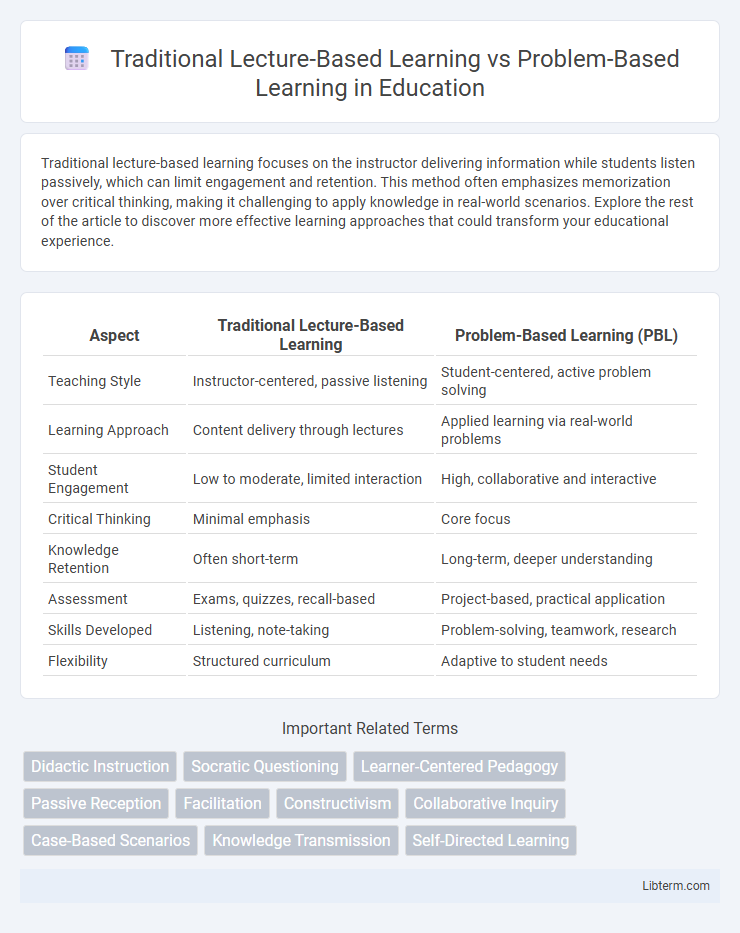Traditional lecture-based learning focuses on the instructor delivering information while students listen passively, which can limit engagement and retention. This method often emphasizes memorization over critical thinking, making it challenging to apply knowledge in real-world scenarios. Explore the rest of the article to discover more effective learning approaches that could transform your educational experience.
Table of Comparison
| Aspect | Traditional Lecture-Based Learning | Problem-Based Learning (PBL) |
|---|---|---|
| Teaching Style | Instructor-centered, passive listening | Student-centered, active problem solving |
| Learning Approach | Content delivery through lectures | Applied learning via real-world problems |
| Student Engagement | Low to moderate, limited interaction | High, collaborative and interactive |
| Critical Thinking | Minimal emphasis | Core focus |
| Knowledge Retention | Often short-term | Long-term, deeper understanding |
| Assessment | Exams, quizzes, recall-based | Project-based, practical application |
| Skills Developed | Listening, note-taking | Problem-solving, teamwork, research |
| Flexibility | Structured curriculum | Adaptive to student needs |
Introduction to Learning Paradigms
Traditional lecture-based learning emphasizes structured delivery of content by instructors, focusing on memorization and passive knowledge acquisition. Problem-based learning prioritizes student-centered exploration, encouraging critical thinking and application through real-world scenarios. These contrasting learning paradigms highlight the shift from passive reception to active engagement in educational practices.
Defining Traditional Lecture-Based Learning
Traditional Lecture-Based Learning centers on instructor-led presentations where information is delivered to students primarily through lectures and note-taking. This method emphasizes passive knowledge absorption, standardized curricula, and assessment through exams focused on memorization. It is characterized by a clear hierarchy between teachers and students, often limiting active student participation and critical thinking development.
Principles of Problem-Based Learning
Problem-Based Learning (PBL) centers on student-driven inquiry, where learners engage with complex, real-world problems to develop critical thinking and collaborative skills. This approach contrasts with Traditional Lecture-Based Learning by emphasizing active exploration and knowledge construction rather than passive information reception. Core principles of PBL include self-directed learning, interdisciplinary integration, and continuous reflection, fostering deeper understanding and practical application of concepts.
Historical Evolution of Educational Approaches
Traditional lecture-based learning, rooted in ancient Greek and Roman education systems, emphasizes direct transmission of knowledge from teacher to student, prioritizing memorization and structured content delivery. In contrast, problem-based learning (PBL) emerged in the late 1960s, particularly at McMaster University, as a response to the limitations of passive learning, fostering critical thinking and real-world problem-solving skills through student-driven inquiry. This shift reflects a broader educational evolution toward active learning models focused on collaboration, application, and deeper understanding.
Key Differences Between Lecture-Based and Problem-Based Methods
The informal sector often lacks legal protections, social security, and minimum wage guarantees, exposing workers to exploitation and poor working conditions. In contrast, the formal sector provides regulated employment with enforced labor laws, social benefits, and access to healthcare and pensions, promoting worker stability and well-being. The disparity significantly impacts social equity, as informal workers face higher vulnerability without formal rights or institutional support.
Advantages of Traditional Lecture-Based Learning
Traditional lecture-based learning provides a structured environment that facilitates efficient delivery of foundational knowledge to large groups, enabling educators to cover extensive content systematically. This method allows students to absorb information directly from subject matter experts, promoting consistency and clarity in understanding core concepts. Additionally, it supports the development of note-taking skills and helps learners build a strong theoretical framework essential for advanced study and professional practice.
Benefits of Problem-Based Learning
Problem-Based Learning (PBL) fosters critical thinking and real-world problem-solving skills by engaging students in active, collaborative learning environments. It enhances retention and comprehension through hands-on application of knowledge rather than passive listening typical in Traditional Lecture-Based Learning. PBL also promotes self-directed learning and teamwork, essential competencies in modern education and professional settings.
Challenges and Limitations of Each Approach
Traditional lecture-based learning often faces challenges such as passive student engagement, limited opportunities for critical thinking, and difficulty addressing diverse learning styles. Problem-based learning can encounter limitations including increased demand on instructor time, potential gaps in foundational knowledge, and variability in group dynamics affecting student outcomes. Both approaches require careful implementation to balance content delivery with active learning and effective assessment.
Impact on Student Engagement and Outcomes
Traditional lecture-based learning often results in passive student engagement, limiting opportunities for critical thinking and real-world application. Problem-based learning (PBL) significantly enhances student engagement by promoting active participation, collaboration, and problem-solving skills, leading to improved retention and deeper understanding of the material. Studies show that PBL contributes to higher academic achievement and better preparation for practical scenarios compared to conventional lecture methods.
Choosing the Right Method for Modern Education
Traditional lecture-based learning emphasizes structured content delivery and teacher-centered instruction, making it effective for foundational knowledge acquisition. Problem-based learning prioritizes student engagement and critical thinking through real-world problem-solving, fostering deeper understanding and skill application. Selecting the appropriate method depends on educational goals, subject complexity, and learners' needs for active participation or systematic knowledge absorption.
Traditional Lecture-Based Learning Infographic

 libterm.com
libterm.com